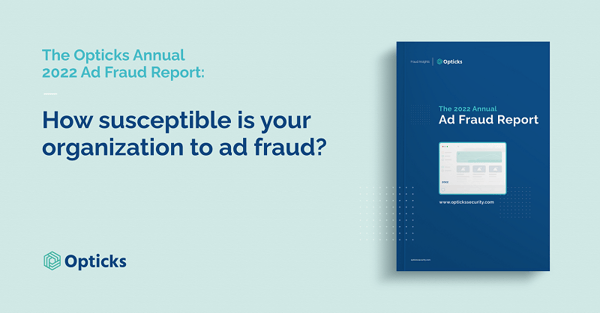Cybernews Interview with Opticks CEO: The State of Global Ad Fraud

 By
Editorial Team
·
4 minute read
By
Editorial Team
·
4 minute read
In this interview, Opticks CEO Eduardo Aznar sat down with the Cybernews team to discuss the past, present, and future of ad fraud.
How did the idea of Opticks come about? What has the journey been like?
Digital advertising grew exponentially in the last two decades. In this process, advertisers have had to rely more and more on indirect forms of advertising where the advertisers have no direct relationship with the publishers that place their ads. While this has brought about many benefits in terms of scalability, it has also placed the most challenging threats especially when it comes to trust in the quality of traffic.
Indeed, publishers have been able to fake the advertising events (like clicks) with little or no consequences. We developed Opticks to make digital advertising fair and transparent. We wanted to protect stakeholders in the marketing value chain from ad fraud and help advertisers make the right advertising decisions.
Can you introduce us to what you do? What methods do you use to detect online fraud?
At Opticks, we help global marketing leaders to increase the return on their advertising spend (that is, how much money they make out of one unit of investment in ads). We do this by providing them with a bundle of detection, prevention, and intelligence solutions that help them to beat invalid traffic and ad fraud.
Powered by expert knowledge and artificial intelligence, Opticks currently analyzes more than 2 billion events daily. We monitor our clients’ traffic and help our clients block fraudulent paid media in real time before they deplete their budgets and pollute their data. At the core, we make it radically easy to accurately track and stop sophisticated online advertising fraud.
What cyber threats affecting online businesses do you find the most concerning at the moment?
As was identified by HP in their whitepaper The Business of Hacking, ad fraud is the most prevalent cybercrime globally. Ad fraud is a major, multi-billion-dollar threat to everyone in the digital advertising industry. Click farms, botnets, and bad bots are just a few of the inventive and hard-to-detect methods fraudsters are using, leading to a loss of $120bn in 2022 alone, as mentioned in a recent report from the Association of National Advertisers.
Our experience in the field of course supports these conclusions. Fraudsters successfully capture a relevant share of advertisers’ budgets that would otherwise be spent on real users. The percentage of advertising fraud can vary from about 3% to 80% depending on the channel, geography, industry, etc. The budget lost due to ad fraud deters advertisers from hitting their targets across the organisation: from the Return on Ad Spend (ROAS) to the customer acquisition cost (CAC).
Furthermore, fake traffic artificially skews analytics, significantly hampering the decision-making on where to invest the advertising budget. The lack of visibility into the origin and nature of fraud makes it really hard for advertisers and agencies to tackle the problem – and they end up sacrificing entire channels and campaigns due to the malpractice of a few specific traffic sources.
How do you think recent global events have altered your field of work? Were there any new challenges you had to adapt to?
In the face of COVID-19, the advertising ecosystem experienced moments of turbulence (i.e. budget cuts, freezes, and layoffs) combined with sudden bursts of investments. But far from that period, advertising has regained the consistency it had previously.
Although it is still widely misunderstood and undervalued, recent global cases of ad fraud (including that of Uber, who discovered that roughly two-thirds of its ad budget was lost due to ad fraud) have helped create an increased awareness of the topic. As a growing and ongoing battle, we see now more marketers are implementing measures to tackle it.
Our 2022 Ad Fraud Report indicates how the biggest threats faced by the digital advertising industry worldwide are increasingly sophisticated bad bots.
Besides fraud protection, what other security measures do you think are essential for every modern business?
Besides fraud protection, we think it is essential for modern businesses to be trusted by their customers, and in our experience, this requires guaranteeing the privacy and security of their personal data.
At Opticks, we value our clients’ (and their customers’) rights to privacy. We keep track of the latest updates and make changes across the entire company to ensure we are fully complying with the latest regulations. A very well-known example of regulation is the GDPR (i.e., General Data Protection Regulation), where we have taken the necessary steps to fully comply with.
In your opinion, what characteristics make a company an attractive target for fraudsters?
Fraudsters are particularly interested in companies that usually have three features. First, the most attractive targets invest large budgets in digital advertising.
Second, they usually have external advertising decision-making, which means they rely on affiliates, agencies, or other partners. The more intermediaries, the more difficult it becomes for these companies to actually track the source of the traffic and quality, and to hold them accountable.
Third, companies working with a PPC revenue model (i.e., paying per click) are an attractive target as it is easy for fraudsters to deceive them.
However, the findings from our 2022 Ad Fraud Report show that all industries, verticals, and geographies are vulnerable to ad fraud. Plus, all channels are exposed to ad fraud, with indirect affiliate, native, and programmatic marketing being the most at risk. In other words, any marketer conducting online advertising is a potential target for fraudsters.
Why do you think new business owners are often unaware of the risks they are exposed to?
As mentioned above, ad fraud will cost $120 billion to the industry in 2022 alone. Despite that, only a small percentage of advertisers are aware of the magnitude of this problem, but even those have limited visibility of the quality and validity of the visits and events in their campaigns.
The main reason for this lack of awareness is that ad fraud is a non-visible and non-tangible problem. The second reason is that only expert solutions are able to detect ad fraud. Ignorance and a lack of expertise lead business owners to underestimate the impact of ad fraud.
Also, advertising intermediaries are often unaware of the problem, or despite being aware, they are sometimes incentivized to drive fake traffic.
How do you think the advertising landscape is going to evolve in the near future?
Marketers are focusing and investing more and more in the Bottom of the Funnel (that is the events that are closer to the transaction itself, such as clicks, leads, or sales themselves) than on the Top of the Funnel (impressions). In addition, as third-party cookies are disappearing, advertisers need to rely on other (new) ways to advertise efficiently, such as first-party cookies.
And finally, what does the future hold for Opticks?
As advertising spending increases at a fast pace, losses due to advertising fraud are also expected to increase and will cost about $120 billion to advertisers worldwide in 2022. In parallel, advertisers are going to become more knowledgeable about advertising fraud.
As is the case with the whole antifraud space, fighting ad fraud is a “cat and mouse” situation. We need to continuously invest in R&D to maintain ourselves (and our clients’ investments) steps ahead of fraudsters.
This article originally appeared on Cybernews.
